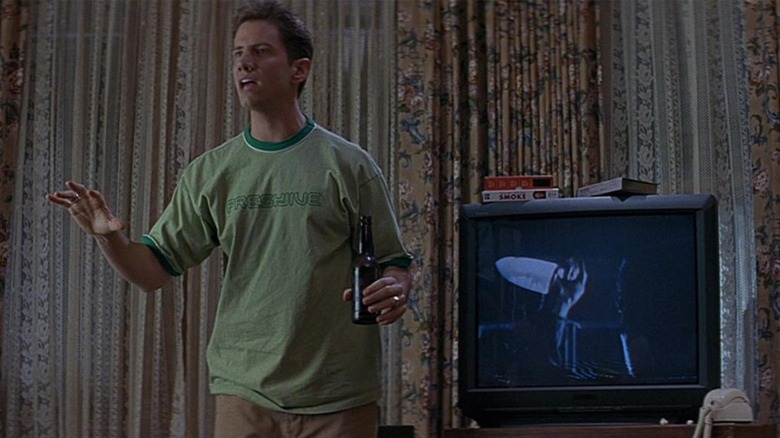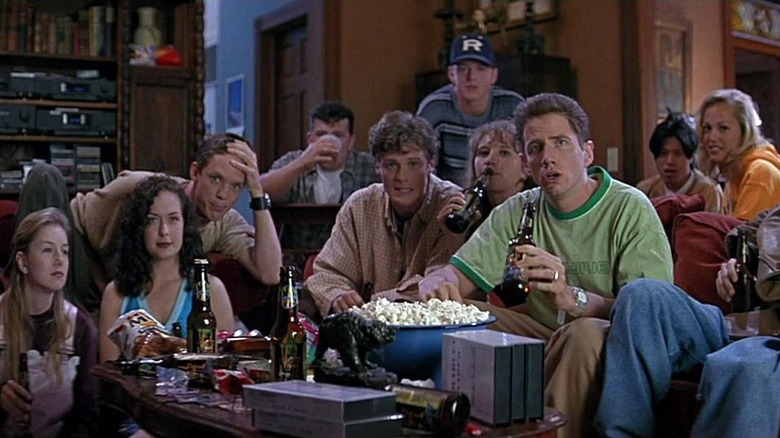Shooting Scream's Rules Scene Taught Jamie Kennedy An Unforgettable Lesson
Wes Craven's 1996 film "Scream" famously rebooted the entire horror genre for a new generation. The slasher glut of the 1980s had decidedly come to an end, and horror tropes migrated over to respectable Hollywood serial killer dramas; "The Silence of the Lambs" led the charge in this regard. "Scream" revitalized the slasher genre, but in a way that allowed it to be self-aware. The characters in "Scream" were all well-versed in horror films of the '70s and '80s, and recognized when they were in a slasher situation. Sidney (Neve Campbell) openly criticized uncreative slasher movies in dialogue, and the movie's masked killer would quiz his victims over the phone. If they forgot that Jason Voorhees wasn't the killer in the first "Friday the 13th" movie — it was his mother Pamela — then he would be justified in attacking.
In one of the film's most notable scenes, the video store clerk Randy (Jamie Kennedy) pauses a VHS copy of John Carpenter's "Halloween" to address a living room full of partygoers, eager to tell them the proper rules of survival in slasher movies. Randy points out that characters who have sex in slasher movies tend to get killed first. The same applies to those who drink or do drugs. Only virginal teetotalers survive. He also warns against saying phrases like "I'll be right back," knowing that such promises invite murderers.
Randy's Rules became a hallmark of the six-film series (with a seventh on the way), as each installment featured a scene wherein characters would brainstorm how recognizable horror tropes and clichés were applicable to their current situation.
In a 2021 retrospective of "Scream" with EW, Kennedy recounted how filming the Rules scene taught him a valuable lesson as a professional film actor. Namely: ask for a second take.
Gen-X media obsession
Kennedy was nervous to shoot the Rules scene, as he understood how important it was to the film's central themes of media obsession. Craven felt that Kennedy did perfectly well on the first take, but that wasn't good enough for Kennedy, feeling he could have done it better. Kennedy asked for a second take, which must have felt like a huge favor coming from a twentysomthing actor with few film credits. Kennedy recalls the request:
"I did it once, and Wes, he liked it. He was like, 'I think I got it.' I was like, 'Oh, man, I'd really love another take"; Wes said, 'Are you sure?' I was like, 'Yeah, I think there's more I could do.' So I did a second take, and Wes let the camera roll, and then I did a third take. Afterward, Wes said, 'Cut, great, print.' Wes said, 'How do you feel?' And I said, 'I feel good.' He said, 'Well, I want to tell you that I'm probably going to use the third take.'"
The third take is the one that audiences saw in the final cut of the film. The lesson here? Craven spelled it out plainly for Kennedy. The actor recalls:
"He goes, 'Never be scared to ask for another take, always trust your instincts.' That was a big lesson for me, not to be scared. That scene really helped me for my whole career. I'm never scared to ask for another take, to confer with the director. Wes really helped me with that."
Poor Randy, quite sadly, was killed by a new murderer in 1997's "Scream 2," although he was able to have a cameo in "Scream 3" thanks to a pre-recorded message made before his death. Knowing the rules couldn't save him.

